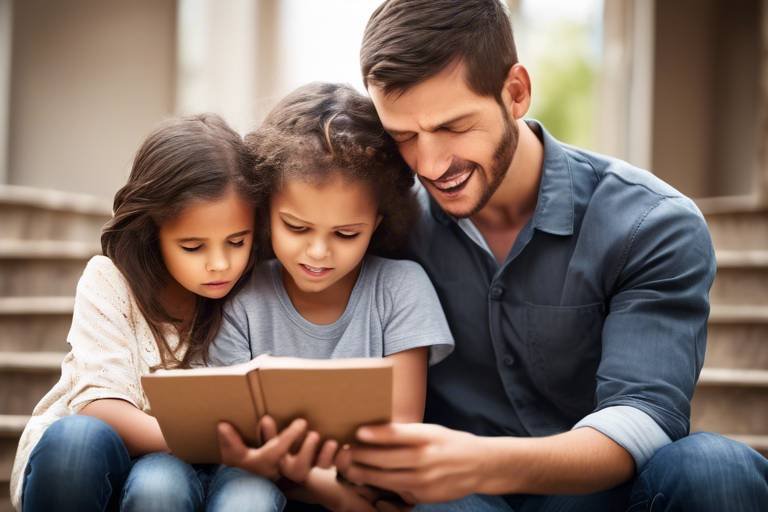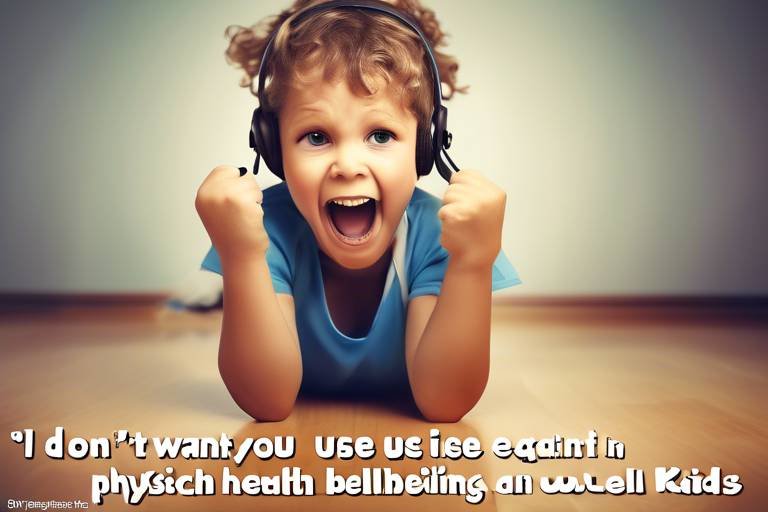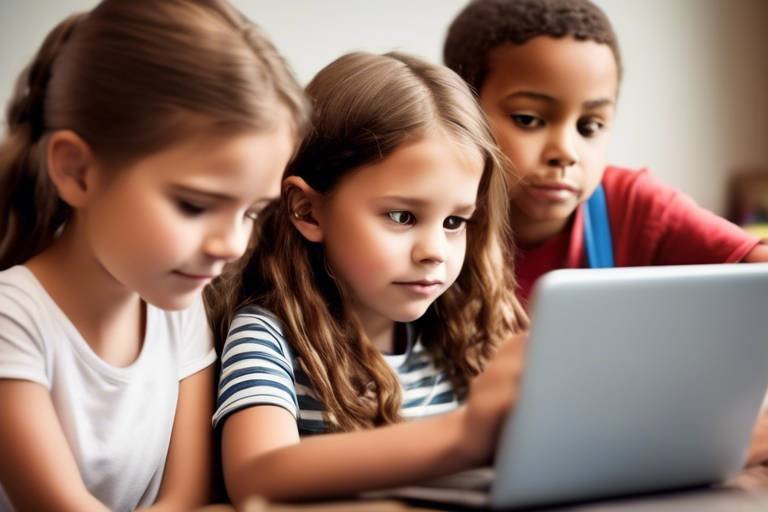Building Emotional Intelligence in Children: A Family Health Perspective
In today's fast-paced world, where emotional well-being is often overlooked, building emotional intelligence (EI) in children is more critical than ever. Emotional intelligence is not just a buzzword; it’s a vital skill that can shape a child’s future, influencing their relationships, academic success, and overall mental health. Imagine equipping your child with the tools to navigate their feelings and understand the emotions of others—this is the essence of emotional intelligence.
So, what exactly is emotional intelligence? It encompasses a range of skills, including the ability to recognize and manage one's own emotions, as well as the capacity to empathize with others. Think of it as a toolkit for emotional navigation. Just as a sailor learns to read the winds and tides, children equipped with emotional intelligence can better understand the emotional currents around them. This not only aids in personal development but also fosters healthier relationships with peers and family members.
As families, we play a pivotal role in nurturing this emotional growth. The environment we create at home can either encourage or hinder a child's emotional development. Family dynamics, communication styles, and the emotional climate of the household significantly impact how children learn to express and manage their feelings. By fostering an atmosphere of open communication, trust, and understanding, we can help our children thrive emotionally.
In the following sections, we will explore effective strategies that families can implement to nurture emotional intelligence in their children. From positive communication techniques to engaging activities, we will delve into practical ways to enhance EI, ensuring that our children grow into emotionally resilient adults. So, let’s embark on this journey together and discover how we can build a healthier, emotionally aware future for our families.

Understanding Emotional Intelligence
Emotional intelligence (EI) is more than just a buzzword; it’s a vital skill set that shapes how children navigate their feelings, interact with others, and deal with challenges. At its core, EI encompasses the ability to recognize, understand, and manage emotions—both in oneself and in others. Imagine EI as a toolbox filled with essential tools for emotional and social success. Just like a carpenter needs the right tools to build a sturdy house, children need emotional intelligence to build strong relationships and cope with life’s ups and downs.
So, what exactly are the components of emotional intelligence? They can be broken down into five key areas:
- Self-awareness: This is the foundation of EI. It’s about recognizing one’s own emotions and how they affect thoughts and behavior.
- Self-regulation: This involves managing emotions in a healthy way, allowing for better control over reactions and impulses.
- Motivation: A child with high EI is often driven by intrinsic motivation, setting goals and striving to achieve them.
- Empathy: This is the ability to understand and share the feelings of others, a crucial skill for building relationships.
- Social skills: These are the tools for interacting well with others, whether it’s in making friends or resolving conflicts.
Understanding these components is essential for parents and caregivers. They serve as a roadmap for fostering emotional intelligence in children. For instance, when children are taught to recognize their feelings, they can express themselves more clearly and avoid misunderstandings. It’s like giving them a map to navigate the often turbulent waters of emotions.
Moreover, the significance of emotional intelligence in childhood development cannot be overstated. Research shows that children with high EI tend to have better academic performance, improved relationships, and enhanced mental health. They are more resilient, able to bounce back from setbacks and face challenges head-on. Think of EI as a protective shield that helps children weather the storms of life, making them not just survivors but thrivers.
In conclusion, understanding emotional intelligence is the first step toward nurturing it. By recognizing its components and significance, families can create an environment that promotes emotional growth and resilience. This foundational knowledge will pave the way for effective strategies that can be implemented in everyday life, leading to healthier, happier children.

The Role of Family in Developing EI
Family is the first social unit a child interacts with, making it a pivotal environment for developing emotional intelligence (EI). The dynamics within a family can either nurture or hinder a child's ability to understand and manage their emotions. When parents and caregivers actively engage in emotional discussions, children learn to recognize their feelings and those of others. This early exposure is crucial because it sets the foundation for how they will relate to the world around them. Think of it like planting a seed; the nurturing environment of a family can help that seed grow into a strong, resilient tree capable of withstanding life's storms.
Moreover, the way family members communicate plays a significant role in shaping a child's emotional landscape. For instance, families that practice open dialogue create a safe space for children to express their feelings without fear of judgment. This openness encourages children to articulate their emotions, fostering a sense of security and belonging. In contrast, families that dismiss or ridicule emotional expression may inadvertently teach children to suppress their feelings, leading to difficulties in emotional regulation later in life. The difference in these environments can be stark, much like the difference between a flourishing garden and a barren desert.
To illustrate the importance of family in developing EI, consider the following key areas:
- Emotional Modeling: Children learn by observing their parents. When parents demonstrate healthy emotional responses, children are likely to mimic these behaviors.
- Supportive Communication: Encouraging children to share their thoughts and feelings fosters emotional growth. This can be achieved through regular family meetings or casual conversations.
- Conflict Resolution: Families that navigate conflicts constructively teach children how to manage disagreements and understand varying perspectives.
In this context, it's essential for parents to be aware of their own emotional expressions. When parents openly discuss their feelings, whether it’s joy, frustration, or sadness, they model the importance of emotional honesty. This not only helps children understand that experiencing a range of emotions is normal but also teaches them how to cope with those feelings effectively. Think of it as a dance; if one partner leads gracefully, the other learns to follow in rhythm.
Furthermore, the family's collective emotional health plays a crucial role in shaping a child's EI. A family that prioritizes emotional well-being creates an atmosphere of resilience and support. For example, families that engage in regular activities together, such as game nights or outdoor adventures, can strengthen their emotional bonds. These shared experiences provide children with a sense of stability and belonging, essential components in developing their emotional intelligence. By nurturing these connections, families can cultivate an environment where emotional growth thrives.
In conclusion, the family unit is instrumental in fostering emotional intelligence in children. By promoting open communication, modeling healthy emotional behaviors, and creating supportive environments, families can equip their children with the skills necessary to navigate their emotions and relationships effectively. As parents and caregivers, the responsibility lies in creating a nurturing space where children feel safe to explore and understand their emotional worlds.
Q: How can I tell if my child has emotional intelligence?
A: Signs of emotional intelligence in children include empathy towards others, the ability to express their feelings appropriately, and the capacity to manage their emotions in challenging situations.
Q: What are some daily activities to promote emotional intelligence?
A: Engaging in conversations about feelings, practicing mindfulness exercises, and role-playing different scenarios can all enhance a child's emotional intelligence.
Q: Can emotional intelligence be developed later in life?
A: Yes, while early childhood is a critical period for developing emotional intelligence, it can be cultivated at any age through intentional practice and learning.

Positive Communication Techniques
Effective communication is the cornerstone of building emotional intelligence in children. When parents engage in positive communication, they create a safe space for their children to express their feelings and thoughts. One of the most important techniques to foster this environment is through open-ended questions. Instead of asking, "Did you have a good day?", try asking, "What was the best part of your day?" This encourages children to elaborate on their experiences and feelings, promoting deeper conversations.
Another crucial aspect of positive communication is validation. When children share their emotions, it’s vital for parents to acknowledge those feelings. For example, if a child expresses frustration about homework, instead of dismissing it, a parent could say, "I understand that homework can be tough sometimes." This validation helps children feel heard and understood, which is essential for their emotional growth.
In addition to open-ended questions and validation, non-verbal communication plays a significant role in emotional exchanges. Parents should be mindful of their body language, facial expressions, and tone of voice. For instance, kneeling down to a child’s level while maintaining eye contact can convey that you are genuinely interested in what they have to say. This simple act can make a world of difference in how children perceive their parents’ engagement.
Furthermore, it’s important to practice active listening. This means not just hearing the words your child is saying, but really understanding the emotions behind them. Techniques like summarizing what your child has said or reflecting back their feelings can reinforce that you are paying attention. For example, if your child says they are upset about a friend not playing with them, you might respond with, "It sounds like you feel really sad because you wanted to play together." This approach not only validates their emotions but also encourages them to articulate their feelings more clearly.
Lastly, incorporating family discussions into your routine can significantly enhance communication. Setting aside time each week for family meetings allows everyone to share their thoughts and feelings in a structured way. This practice not only strengthens family bonds but also teaches children the importance of expressing themselves in a supportive environment. During these meetings, parents can model effective communication techniques, demonstrating how to express feelings, resolve conflicts, and offer support.
In summary, positive communication techniques are essential for nurturing emotional intelligence in children. By using open-ended questions, validating feelings, practicing active listening, and fostering regular family discussions, parents can create an atmosphere where emotional expression is welcomed and encouraged. This not only benefits the child’s emotional development but also strengthens the overall family dynamic.

Active Listening Skills
Active listening is more than just hearing the words that come out of your child's mouth; it's about diving deep into their emotional world and truly understanding what they are feeling. When parents engage in active listening, they create a safe space for their children to express themselves without fear of judgment. Imagine a cozy living room where the atmosphere is warm and inviting—this is the kind of environment you want to foster during conversations with your child. Instead of simply nodding along while scrolling through your phone, make a conscious effort to **put everything aside** and focus entirely on your child's words. This simple act can significantly impact their emotional development.
So, how can you master the art of active listening? Here are some practical techniques that can help:
- Maintain Eye Contact: This shows your child that you are fully present and engaged in the conversation. It reinforces the idea that their feelings matter.
- Use Affirmative Nods or Words: Simple gestures like nodding or saying “I see” can encourage your child to continue sharing their thoughts and feelings.
- Reflect Back What You Hear: Paraphrasing what your child has said helps them feel understood. For example, if your child says, “I’m sad because my friend didn’t invite me to the party,” you might respond with, “It sounds like you’re feeling left out.” This not only validates their feelings but also encourages them to elaborate.
- Avoid Interrupting: Let your child finish their thoughts before you respond. This shows respect for their feelings and allows them to express themselves fully.
By implementing these techniques, you will not only enhance your child's ability to articulate their emotions but also model the importance of effective communication. Think of it as planting seeds in a garden; the more you nurture those seeds with attention and care, the more they will flourish. Active listening can be a transformative experience for both you and your child, creating a bond that is built on trust and understanding.
As you practice these skills, remember that active listening is a journey, not a destination. There will be times when distractions pull your focus away, but that’s perfectly normal. The key is to recognize those moments and gently steer your attention back to the conversation. Over time, your child will feel increasingly comfortable sharing their thoughts and emotions, knowing that you are there to listen.
In essence, active listening is like a mirror reflecting your child's emotional state back to them. It helps them see their feelings clearly and understand that they are valid. When children feel heard, they are more likely to develop a strong sense of emotional intelligence, which can lead to better relationships and overall well-being in the long run.
1. What is active listening?
Active listening is the practice of fully concentrating, understanding, responding, and remembering what is being said during a conversation. It's about being present and engaged with the speaker.
2. How can I tell if my child feels heard?
If your child continues to open up and share their thoughts and feelings with you, it’s a good sign that they feel heard. Additionally, they may express gratitude or relief after having a conversation.
3. What if I struggle with active listening?
It’s completely normal to find active listening challenging at first. Start by practicing the techniques mentioned above and gradually incorporate them into your daily interactions. Over time, it will become more natural.
4. Can active listening improve my relationship with my child?
Absolutely! Active listening fosters trust and understanding, which are essential for a healthy parent-child relationship. It allows your child to feel valued and respected, strengthening your bond.

Modeling Emotional Responses
When it comes to teaching children about emotions, one of the most powerful tools at our disposal is . Children are like sponges; they absorb everything around them, especially the behaviors and reactions of their parents and caregivers. This means that the way we handle our own emotions can significantly influence how they learn to manage theirs. For instance, if a parent reacts to stress with calmness and constructive problem-solving, the child is likely to adopt similar strategies when faced with their own challenges.
It’s essential to remember that children are always watching and learning from us, even when we think they aren’t. When we demonstrate healthy emotional responses, we are not just teaching them how to react; we are also showing them that it’s okay to feel a range of emotions—from happiness to sadness, frustration to joy. This modeling can take many forms:
- Expressing Emotions Openly: When we share our feelings, whether we're excited about a promotion or upset about a bad day, we provide a real-life example of emotional honesty.
- Practicing Emotional Regulation: Instead of exploding in anger when things go wrong, we can demonstrate techniques like deep breathing or counting to ten.
- Showing Empathy: By responding to others' emotions with understanding and support, we teach our children the importance of empathy.
Consider a scenario where a parent faces a minor setback, like spilling coffee on their shirt before a big meeting. Instead of panicking, they might take a deep breath, laugh it off, and calmly clean up the mess. This reaction not only shows the child how to handle unexpected situations but also conveys that mistakes are part of life and can be dealt with gracefully. Modeling these responses helps children develop resilience, an essential trait for navigating the ups and downs of life.
Moreover, it’s important to acknowledge that no one is perfect. We all have moments where we might lose our cool or feel overwhelmed. What matters is how we address those moments afterward. Apologizing to our children and explaining how we could have reacted differently is an opportunity for growth. It teaches them that it’s okay to make mistakes and that learning from them is what truly counts.
In conclusion, by consciously modeling healthy emotional responses, we can equip our children with the tools they need to understand their own emotions and respond to others in a compassionate way. This foundational skill not only enhances their emotional intelligence but also fosters deeper connections within the family and beyond.
- What is emotional intelligence? Emotional intelligence is the ability to recognize, understand, and manage our own emotions as well as the emotions of others.
- How can I help my child develop emotional intelligence? You can help by modeling healthy emotional responses, encouraging open communication, and engaging in activities that promote empathy.
- Are there specific activities that can enhance emotional intelligence? Yes, activities like role-playing and mindfulness practices can significantly boost a child's emotional awareness and regulation.

Encouraging Empathy in Children
Empathy is a fundamental building block of emotional intelligence. It’s that magical ability to step into someone else’s shoes and feel what they’re feeling. But how do we, as parents and caregivers, nurture this precious quality in our children? It’s not just about telling them to be kind; it’s about creating an environment where empathy can flourish naturally. Imagine teaching your child to recognize when a friend is sad, not just to be nice, but because they genuinely understand the weight of that sadness. This is the essence of empathy.
One effective way to encourage empathy is through storytelling. When children hear stories, especially those that explore different characters’ emotions, they begin to see the world through various lenses. Try reading books that highlight diverse experiences and emotions. Afterward, engage your child in a discussion about how the characters felt and why. Ask questions like, “How do you think they felt when that happened?” or “What would you have done in their place?” This not only sparks conversation but also encourages critical thinking about emotions.
Another powerful method is to involve children in community service activities. Volunteering can open their eyes to the struggles of others, fostering a deeper understanding of different life situations. Whether it’s helping at a local shelter, participating in a food drive, or simply assisting a neighbor, these experiences can profoundly impact a child’s ability to empathize. When children see the world beyond their own experiences, they begin to grasp the concept of compassion in a tangible way.
Additionally, modeling empathetic behavior in your daily interactions is crucial. Children are like sponges; they absorb what they see. When they witness you responding to others with kindness and understanding, they learn to replicate those behaviors. Share your feelings openly and discuss how you manage them. For instance, if you’re having a tough day, talk about it: “I felt really overwhelmed today, but talking to a friend helped me feel better.” This teaches children that it’s okay to express emotions and that empathy can lead to connection and support.
Lastly, encourage your child to practice empathy through role-playing. Create scenarios where they can act out different emotional situations. For example, you might pretend to be a friend who lost a pet, and ask your child how they would respond. This not only helps them think on their feet but also gives them a safe space to explore their feelings and reactions. By engaging in these exercises, children learn to navigate emotional landscapes with more awareness and sensitivity.
Incorporating these strategies into your family routine can cultivate a rich atmosphere of empathy. Remember, it’s not about perfection; it’s about progress. Each small step you take in encouraging empathy in your children can lead to a lifetime of emotional intelligence and resilience.
- What is emotional intelligence? Emotional intelligence is the ability to recognize, understand, and manage our own emotions while also being able to recognize and influence the emotions of others.
- Why is empathy important for children? Empathy helps children develop strong relationships, enhances their social skills, and contributes to their overall emotional well-being.
- How can I tell if my child is developing empathy? Signs of developing empathy include your child showing concern for others, being able to articulate feelings, and demonstrating caring behaviors.
- What activities can boost my child’s empathy? Activities such as reading diverse stories, volunteering, role-playing, and discussing emotions can significantly enhance empathy in children.

Activities to Enhance EI
Engaging in specific activities can significantly boost a child's emotional intelligence (EI). Think of it as a gym for the mind and heart, where every exercise strengthens their ability to understand and manage emotions. Just like physical fitness, emotional intelligence requires regular practice and dedication. So, what can families do to cultivate this vital skill together? Let's dive into some enjoyable and interactive activities that can make a real difference!
One of the most effective ways to enhance EI is through role-playing scenarios. This activity allows children to step into different shoes and experience various emotions and situations firsthand. Imagine your child pretending to be a doctor, a teacher, or even a superhero facing a dilemma. These imaginative exercises not only spark creativity but also provide a safe space for kids to explore feelings like empathy, frustration, or joy. To create effective role-playing exercises, consider the following tips:
- Choose relatable scenarios that your child might encounter in real life.
- Encourage them to express how they feel in each role.
- Discuss the outcomes of the scenarios and what they learned from them.
Another delightful way to boost emotional intelligence is through mindfulness practices. Mindfulness is all about being present in the moment and can significantly enhance a child's emotional awareness. Think of it as a mental reset button that helps children recognize their feelings without judgment. Simple exercises can be integrated into daily routines, such as:
- Breathing exercises: Encourage your child to take deep breaths and focus on their breath for a few minutes.
- Gratitude journaling: Have them write down three things they are grateful for each day.
- Nature walks: Take a walk in nature and discuss the sights, sounds, and feelings they experience.
These mindfulness practices not only improve emotional regulation but also foster self-awareness in children. By taking a moment to pause and reflect, they learn to identify their feelings and the feelings of those around them. This skill is essential for developing empathy, which we discussed earlier.
Lastly, consider incorporating games that promote emotional learning. Board games and card games that require players to express emotions or solve problems together can be both fun and educational. Games like "The Emotionary" or "Feelings Charades" can help children articulate their feelings and understand the emotions of others. Not only do these activities build EI, but they also create cherished family memories.
In conclusion, enhancing emotional intelligence in children is a journey that can be both enjoyable and rewarding. By engaging in role-playing, mindfulness practices, and emotion-focused games, families can create a nurturing environment that fosters emotional growth. Remember, the key is consistency and open communication—so make it a family affair!
Q: At what age should I start teaching my child about emotional intelligence?
A: It's never too early to start! You can begin introducing basic concepts of emotions and empathy as early as preschool age.
Q: How can I tell if my child is developing emotional intelligence?
A: Look for signs such as improved communication, better conflict resolution skills, and increased empathy towards others.
Q: Are there specific books or resources to help teach emotional intelligence?
A: Absolutely! There are many children's books focused on emotions, such as "The Feelings Book" by Todd Parr and "The Color Monster" by Anna Llenas, which can serve as great tools.

Role-Playing Scenarios
Role-playing scenarios are not just a fun activity; they are a powerful tool for helping children navigate the often complex world of emotions and social interactions. Imagine a child stepping into the shoes of a character, feeling their emotions, and experiencing their challenges firsthand. This immersive experience can foster a deeper understanding of empathy and emotional regulation. By creating realistic situations, families can help children practice responding to various emotional cues, which is essential for developing emotional intelligence.
To create effective role-playing exercises, consider the following steps:
- Choose Relevant Scenarios: Select situations that your child may encounter in their daily life, such as resolving a conflict with a friend, expressing disappointment, or even celebrating someone else’s success.
- Set the Scene: Create a comfortable environment where your child feels safe to express themselves. Use props or costumes if necessary to make the experience more engaging.
- Encourage Dialogue: Allow your child to express their feelings and thoughts during the role-play. Ask open-ended questions to guide them through the scenario, prompting them to think critically about their responses.
For example, if you choose a scenario where a child is feeling left out during a game, you can role-play the situation together. One parent can act as the child who feels excluded, while the other plays the role of a friend. This exercise allows the child to explore both perspectives, helping them understand the feelings of exclusion and the importance of inclusion. After the role-play, take a moment to discuss how each character felt and what could be done differently to resolve the situation positively.
Role-playing not only aids in emotional understanding but also helps children develop problem-solving skills. When they are faced with a challenging situation, they can draw from their role-playing experiences to find constructive solutions. This practice can be likened to a rehearsal for life—just as actors prepare for a performance, children can prepare for real-life situations through these engaging activities.
Moreover, role-playing can strengthen family bonds as everyone gets involved in the act, sharing laughter and learning moments. It’s a delightful way to spend time together while also focusing on the critical development of emotional intelligence. So, gather your family, choose a scenario, and let the role-playing begin!
Q1: How often should we engage in role-playing activities?
A1: It's beneficial to incorporate role-playing into your routine, perhaps once a week or whenever a relevant situation arises. The key is consistency and making it a fun experience!
Q2: What age is appropriate for role-playing scenarios?
A2: Children as young as three can participate in simple role-playing games, while older children can handle more complex scenarios. Tailor the activities to your child's age and understanding.
Q3: Can role-playing help with anxiety in children?
A3: Absolutely! Role-playing can help children process their feelings and reduce anxiety by providing them with coping strategies and a safe space to express their emotions.

Mindfulness Practices
In our fast-paced world, teaching children mindfulness practices is like giving them a superpower to manage their emotions and enhance their emotional intelligence. Mindfulness is all about being present in the moment, acknowledging feelings without judgment, and cultivating a sense of calm. Imagine your child as a little tree swaying in the wind; mindfulness helps them stay rooted, no matter how strong the gusts of life may be.
One of the easiest ways to introduce mindfulness to children is through simple breathing exercises. For instance, you can encourage your child to take a deep breath in for a count of four, hold it for four, and then exhale for four. This practice not only calms the mind but also helps them recognize when they are feeling overwhelmed. You might say, "Let’s pretend we’re blowing up a big balloon! Inhale deeply, and now let’s blow it out slowly." This playful approach makes it engaging and fun, transforming a basic breathing exercise into an exciting game.
Another effective mindfulness practice is body scanning. This technique involves focusing attention on different parts of the body, starting from the toes and moving up to the head. You can guide your child through this process by saying, "Let’s start at our toes. How do they feel? Are they warm or cold? Now let’s move to our feet." This not only helps children tune into their physical sensations but also encourages them to recognize how their bodies react to different emotions.
To make mindfulness a family affair, consider setting aside a few minutes each day for a mindfulness moment. This could be as simple as sitting together in silence, enjoying nature, or even engaging in a short meditation session. You could say, "Let’s take a few minutes to listen to the sounds around us. What do you hear? Can you hear the birds? How about the wind?" This practice fosters connection and encourages children to articulate their feelings and observations.
Additionally, incorporating mindful storytelling can be a wonderful way to enhance emotional awareness. Choose a story that resonates with feelings, and after reading, discuss the emotions of the characters. Ask questions like, "How do you think the character felt when that happened? What would you have done in their place?" This not only promotes empathy but also helps children recognize and articulate their own emotions.
Finally, it’s essential to create a mindfulness-friendly environment at home. This could include having a designated quiet space filled with calming elements like soft cushions, dim lighting, or soothing music. Encourage your children to use this space whenever they feel overwhelmed or need a moment to regroup. A little corner with a comfy chair and some calming visuals can become their safe haven.
Incorporating these mindfulness practices into your family routine can significantly enhance your child's emotional intelligence, providing them with the tools they need to navigate life's ups and downs with grace and resilience. Remember, the goal is not perfection but progress; every small step counts in building a more emotionally aware child.
- What age should I start teaching mindfulness to my child? It's never too early! You can start introducing simple mindfulness practices as young as three or four years old.
- How long should mindfulness sessions be? For young children, even a few minutes can be effective. As they grow older, you can gradually increase the duration.
- Are there specific mindfulness apps or resources for children? Yes, there are several apps designed for kids that offer guided meditations and mindfulness exercises, such as "Headspace" and "Calm."
- Can mindfulness help with anxiety in children? Absolutely! Mindfulness practices can help children recognize and manage their anxiety, promoting a sense of calm and control.
Frequently Asked Questions
- What is emotional intelligence and why is it important for children?
Emotional intelligence (EI) is the ability to recognize, understand, and manage emotions in oneself and others. For children, developing EI is crucial as it helps them navigate social interactions, build relationships, and cope with challenges. Essentially, it lays the foundation for their overall emotional and mental well-being.
- How can families foster emotional intelligence in their children?
Families can foster emotional intelligence by creating an environment that encourages open communication, active listening, and emotional expression. Engaging in discussions about feelings, modeling healthy emotional responses, and practicing empathy can significantly enhance a child's emotional growth.
- What are some effective communication techniques for parents?
Effective communication techniques include using open-ended questions to encourage dialogue, practicing active listening by giving full attention to the child, and validating their feelings. This helps children feel heard and understood, which is essential for their emotional development.
- How can role-playing help children develop emotional intelligence?
Role-playing allows children to explore various social situations and emotions in a safe environment. By acting out scenarios, they can practice empathy, understand different perspectives, and learn how to respond to various emotional challenges, thereby enhancing their emotional intelligence.
- What mindfulness practices can families do together?
Families can engage in simple mindfulness practices such as deep breathing exercises, guided imagery, or mindful walking. These activities promote emotional awareness and help children learn to regulate their emotions, leading to improved self-awareness and emotional resilience.
- Can emotional intelligence be taught, or is it innate?
While some aspects of emotional intelligence may be innate, it can certainly be taught and developed over time. Through consistent practice, modeling, and supportive interactions, parents can help their children enhance their emotional skills and awareness.
- What role does empathy play in emotional intelligence?
Empathy is a cornerstone of emotional intelligence. It allows children to understand and share the feelings of others, fostering deeper connections and healthier relationships. Teaching empathy helps children navigate social complexities and enhances their overall emotional awareness.



















